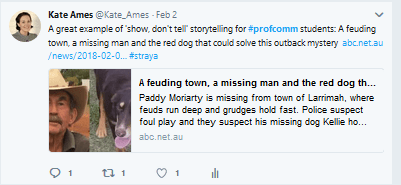If you’re transitioning to teaching students online, then you’re possibly in one of two camps: you’re resistant because you believe face-to-face teaching is better, or you’re resigned because you know it is a matter of when, not if.
Finding a truly passionate distance educator in a field where much of the learning has to be practical (how to write, use a camera, record sound) has, in my experience, been difficult. Most people design curriculum with the on-campus student in mind, and then make amendments for the distance student.
However, journalism education by distance seems a natural fit. Journalists routinely have to work remotely, receiving briefs from editors thousands of miles away. They create and file stories using a diverse range of technologies, and need to be mobile, adaptable, social and able to negotiate complexity when conducting research.
So thinking of the roving correspondent, who can’t make it for critical training, is a way to conceptualize our students. I was inspired to think this way after working with a colleague at the 1996 Atlanta Olympics. He saw the future and tried to talk to us about “this thing called the internet.” He spent the fortnight on the media bus filing these digital stories while the rest of us worked manually. He was learning as he went, blowing us all away with his ability to file stories as instantly as was possible back then.
I started, and continue, to design courses and assessment with him in mind. I view everything I see others do in the journalism classroom through the lens of how I would do that with my remote students (such as Aleszu Bajak’s recent fabulous piece about designing a journalism course around email newsletters — still thinking about that one). That’s because most of my students will never make it to the on-campus classroom. No flipped classrooms, no blended learning. My classes are totally online, fully-assessed and contribute to undergraduate bachelor’s degree.
For those new to distance or online education and trying to think about how to include remote students, I offer the following five initial tips to help your transition. They are based on years of mentoring, teaching, coping with a rapidly changing discipline, adjusting course and unit design, assessing and celebrating student success.
1. Shift Your Thinking
To be a great teacher of distance students, you have to believe in what you are doing. You need to be committed to providing the best possible education regardless of personal circumstance, and to pushing boundaries so graduates can be ahead of the game. I regularly hear peers complain about the trend to online education, lamenting how much easier it is to teach face-to-face. Many feel it is too hard to teach technology online and provide instant feedback on writing.
Of course it’s easier to teach face-to-face. But that’s not the point.
If we accept that to be the truth, then we give up the possibilities with our remote students who have stories that need to be told. The more remote the student, the more important it is to give them a voice.
So rather than wondering how we include the distance student, the better question is: How do we make distance students central to learning design? From that position, we can then include everyone else.
Picture the most isolated student who might have the best story to tell, and teach them. What do they need? If they have limited internet or resources, think about how you’re going to address this. Relying on hours of watching video lectures or lots of clips on YouTube may be less effective than asking the student to do the work, reflect, watch a shorter clip that refines their thinking, and do the same task again. Do they really need the latest podcasting kit for the task, or will sound recorded on a mobile be enough? How can you support the student to do in his or her living room what on-campus students might do in a studio?
Working through questions like this will focus you on what’s important rather than what’s easy.
2. Principles Rather than Technology
Technology is great and has been at the heart of discussions about journalism education for a while. However, it can dominate discussion at the expense of good learning design. Platforms change. Software changes. But the principle of telling a good story, verifying facts and making it interesting to readers or viewers doesn’t.
Where you need to use a technology, make it the industry standard. If there’s no industry standard, or newsrooms use different filing software platforms, then use something that’s transferable. For example, SoundCloud might be better and easier to use than Audacity, depending on the learning outcome.
Make use of existing learning materials, but don’t let students wander around looking for them.
Recommend a good tutorial on how to use Twitter, for example, or create a very short video yourself. But think more broadly about what you want the student to learn and do – creating connections, identifying sources, verifying facts. Twitter may be the best option, but maybe not—maybe the student can actually come to you with something better. It’s the principle that’s important.
3. Keep it simple
Students are easily overwhelmed with too much information, and we have a tendency in online environments to overload them with content and links, just because we can. We know that students generally are time poor and usually juggling multiple commitments. We also know that they will do what is required for assessment, but that assessment must consider time related to task. Distance students are particularly vulnerable to simply disappearing if it all gets too hard or too overwhelming. 
If you study with me, you’ll get one study guide of around four pages (PDF so you can download it). I’ll only use full texts if they are truly AMAZING. I don’t pad the learning environment with lots of links for the sake of it. If I do include links, I’ll be asking students to reflect/model/review what I am asking them to watch. So, avoid overcomplicating things. Your job as a discipline expert is to provide a platform for learning, and then ask them to find the information (promoting lifelong learning, research skills, information literacy…the list goes on). If I have extra resources or links, I’ll communicate these to students socially (via Twitter, for example).
4. Drive Learning Through Assessment, Not Content
We like to create content. We think we’re teaching students when we transfer knowledge. However, creating space for learning, and limiting content to support achieving the learning outcomes, is critical. Journalism is inherently social. Designing authentic learning tasks that facilitate connections requires you to be innovative, particularly in the ways you provide feedback and support to students without overwhelming yourself.
It is critical to front load your units or courses. Good orientation, clear instructions and minimal updates while the course is running will help you focus on engaging with students as a mentor and providing feedback rather than putting out bushfires.
5. Build confidence
Building confidence in distance student cohorts is difficult but crucial. Our journalism students need to be confident in their news-sense, and research, analytical and technical skills. We need them to back themselves when they identify a difficult story, and they need to cope with the pressures that come from public discourse.
Again, course design and assessment is important. Building in reflection, virtual peer review and collaboration, and response to feedback into assessment can address this. I also ask all my students to self-assess their work (and I teach them how to do this). Distance study requires independence, resilience, time management and self-motivation. Students will always drop out, but my distance students often outperform on-campus students.
When you are new to distance or online teaching, you will be battling on a number of fronts. Those roving correspondents need you to be committed to their success, they need to know how to tell a great story, they need you to guide them on what’s important, they need to learn actively and authentically, and they need to be confident.
If you keep these points at the forefront of your thinking, hopefully the rest will come.
Kate Ames is an associate professor with a background in journalism and public relations education. She works at CQUniversity in Australia and specialises in distance and online learning. She is passionate about providing equal opportunities for access to great education. You can see some of her online teaching in action by following @Kate_Ames on Twitter, or following #speech and #profcomm hashtags associated with @CQUni.

